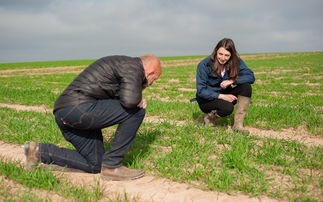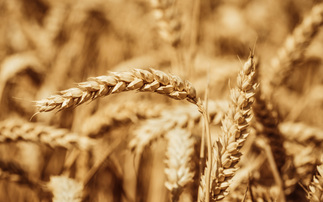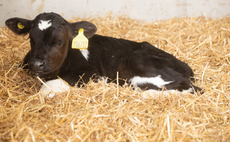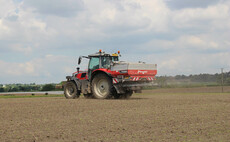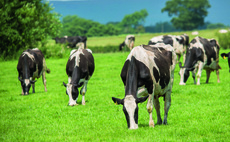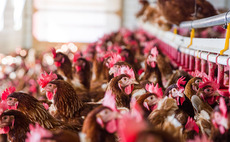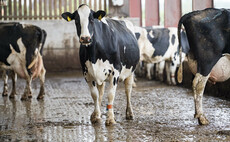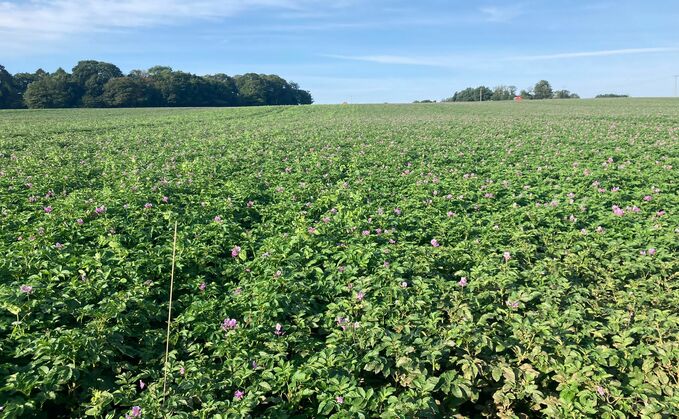
Potatoes companion cropped with peas and beans.
As some landlords turn away from intensively cultivated crops, there is a threat that greater focus on zero-till could further jeopardise the UK's potato area.
John Bubb, who grows combinable crops, potatoes and flowers in east Shropshire has long been focused on his farm's soil health, but more recently he has been honing in on his potato practices with help from a team of experts, and has seen big improvements to both soil health, and the bottom line.
As a first step, introducing cover crops ahead of potatoes and spring-sown flowers was a no-brainer on Mr Bubb's light sandy soils to help in building organic matter reserves. The mix, grown ahead of the potato crop consists of linseed, buckwheat, phacelia, vetch, clover and oats.
"We are trying to grow as diverse a mix as possible with as many species as possible, while still being affordable," explains Mr Bubb's agronomist, Ed Brown, who is head of agroecology for Hutchinsons.
Cover crops
They decided to move away from brassica species after various issues, most notably regrowth within the potato crop particularly if grazed, as well slug issues. And although spring oats have been excellent for soil structure, they are not included in the mix ahead of flowers, as they tend to have a negative allelopathic effect.
With a catch crop also grown between OSR and wheat, a huge part of growing a potato crop regeneratively is what happens in the rest of the rotation, says Mr Brown.
This means taking a whole farm approach to cultivations. Since the introduction of cover crops, soils have become more friable so potato cultivation passes and depth can be reduced, says Mr Bubb.
"In the potatoes we have been able to eliminate some passes, and we try not to plough, using a DTX machine instead. We have reduced the depth of the destoner, which has share tines on it to get rid of any pan, and we are also doing much less bed tilling.
"We have a lot of stones where we are, so stones are an issue and there is concern about bruising at harvest. Some fields we can get away without destoning but on the whole, destoners still have a place to reduce bruising so there is work to be done there."
Tillage
All OSR and flowers are strip tilled and Mr Bubb says that across the whole farm, there is enough machinery to be able to do the right pass on the right day, in the right conditions.
While on the whole, pesticide use has been markedly reduced across the whole rotation, cutting down on blight sprays is a key challenge still yet to be addressed.
Mr Brown says: "Getting away from routine prophylactic blight sprays is quite difficult, because when it goes wrong, it can go spectacularly wrong. We are trying to put in the groundwork now to build healthy soils and plants, and manage nutrition to make plants much more resilient to pathogens like blight. Before too long we will start to pull back where we can."
PCN
However, Mr Bubb has managed to reduce nematicide use from 90 per cent of potato area previously treated, to now just 8 per cent, which he puts down to rigorous soil testing, growing resistant varieties, and keeping a wider rotation.
Mr Brown says: "For me, PCN is a symptom of an unbalanced soil and one that is lacking in diversity of the soil food web. If you are repeatedly damaging soils and killing off beneficial elements and then putting potatoes in on a regular basis, it is no surprise PCN has a chance to thrive because you are removing all the things that would naturally predate on that specific crop pest. Try to rebalance the soil food web so PCN is a very small part of it and never has the chance to thrive."
Key to growing more resilient crops better able to cope with pest and disease has been giving the nutrition programme a complete rehaul, with the help of Ian Robertson of Sustainable Soil Management.
Mr Robertson says: "Every soil has a deep freeze full of loads of complex nutrients. First you need to test the soil to measure what is there, and then look at what can be done in the rotation to cycle those nutrients back to the crop - a key part of this is all about management practices."
In Mr Bubb's soil, testing revealed 1,228kg of total phosphorus, but only 85kg was cycling.
"With cover crops, less cultivations and biological inoculants we are now getting more of that to cycle," Mr Robertson explains.
"The best way to reduce chemical disturbance is to reduce fertiliser use, and allow the soil to become more native, which will improve nutrient cycling."
Nitrogen capture
The addition of cover crops is improving nitrogen capture in the soil profile, and Mr Bubb is also now applying a carbon source alongside nitrogen to balance the carbon:nitrogen ratio to improve NUE.
Crops are monitored through the growing season with SAP analysis to ensure the nutrition programme is delivering everything it needs.
On the back of soil testing, the team has reduced artificial nitrogen from 210kg to 180kg; phosphorus from 80kg to zero; and potassium from 330kg to 154kg.
Not wanting to ‘take their feet off the gas' completely, PC25, a phosphate solubilising bacteria is still being applied, to ensure enough is available to the crop, but Mr Brown is hopeful they will be able to move away from this too.
Mr Robertson says: "There is plenty of phosphate in the soil to grow the crop and now we are only applying potassium to meet crop demand. Potassium was being overfed which was having a negative effect on soil structure, collapsing the soil. By reducing the amount of potash and only feeding the crop requirement rather than offtake, that's had another effect on soil structure. We have reduced nitrogen to the lowest level we thought possible, but we may go lower again."
Nutrition
At the end of last season, taking this tailored approach to crop nutrition resulted in a whopping £345/ha difference in the bottom line.
In hope of further tapping into organic nitrogen, Mr Bubb is trialing wheat grown in 50cm rows, and in May-June, establishing a clover living mulch which he hopes will survive within the rotation for five years until the next potato crop is grown.
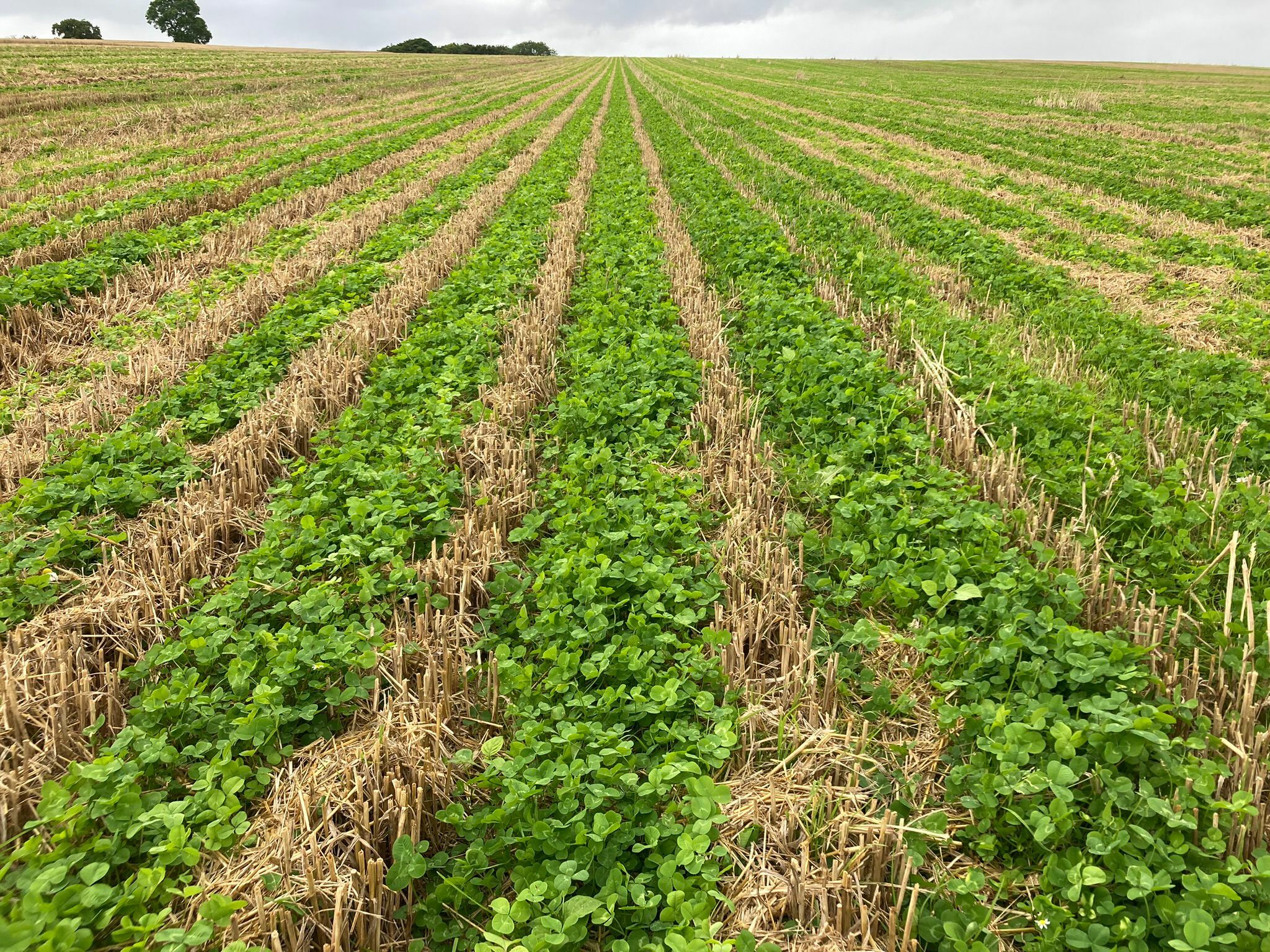
Mr Bubb says: "The idea is to help with plant diversity, give nitrogen to following crops, give green cover to soil and act as a weed suppressant. Eventually, if we can get it working, we're looking at inter-row mowing to manage it in the spring to release nitrogen into the neighboring plant, as well as trying some with DeCyst [trap crops] amongst the clover to help with PCN."
Overall, these management changes have made the crop more resilient and profitable with no noticeable impact on yield.
The increase in organic matter has also helped with water retention and reduced the amount and frequency of irrigation requirements.
Mr Brown says: "Now we are in this process of less tillage, more cover crops and residues, we are seeing physical organic matter in the ridge, rather than just sand which can dry out very quickly or cap so water runs off.
"When you get your head round the principles of regenerative agriculture, it is difficult to see how potatoes fit. But we see it very much as three steps forward and only two steps back, which means over time you are still making progress with soil health. Potatoes are a really important homegrown food source and John is on a soil type suited to growing potatoes, therefore we should be growing them, but we have a responsibility to do it better and have less of an impact."
Groundswell
John, Ed, Ian and James were speaking as part of a Groundswell seminar on linking soil health and potato production.
McCain
Mr Bubb grows 160 hectares of potatoes on contract for McCain, which is doing its own work into regenerative farming to secure a long-term sustainable supply of potatoes, as highlighted in recent television adverts.
With McDonalds its largest customer globally, expectations to explore and invest in regenerative farming is growing, according to McCain agriculture director James Young.
McCain has developed six key principles of regenerative agriculture that can be applied to growing potatoes:
-
Ensure farm resilience
-
Armour soil, preferably with living plants
-
Enhance crop and ecosystem diversity
-
Minimise soil disturbance
-
Reduce agrochemical impact and optimize water use
-
Integrate organic and livestock elements
Farm facts:
-
Based five miles from Harper Adams in Shropshire
-
Sandy loam soil
-
160ha of potatoes grown one in six years
-
Other crops include wheat, OSR and flowers for confetti








